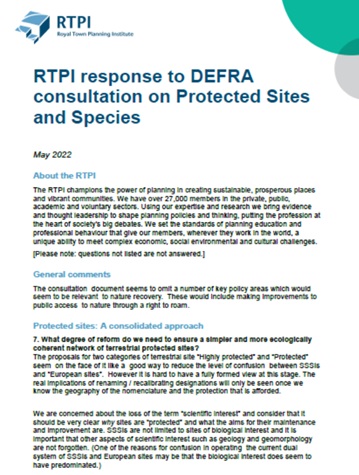 About the RTPI
About the RTPI
The RTPI champions the power of planning in creating sustainable, prosperous places and vibrant communities. We have over 27,000 members in the private, public, academic and voluntary sectors. Using our expertise and research we bring evidence and thought leadership to shape planning policies and thinking, putting the profession at the heart of society's big debates. We set the standards of planning education and professional behaviour that give our members, wherever they work in the world, a unique ability to meet complex economic, social environmental and cultural challenges. [Please note: questions not listed are not answered.]
Read the RTPI's full response or download it in PDF here.
General comments
The consultation document seems to omit a number of key policy areas which would seem to be relevant to nature recovery. These would include making improvements to public access to nature through a right to roam.
Protected sites: A consolidated approach
7. What degree of reform do we need to ensure a simpler and more ecologically coherent network of terrestrial protected sites?
The proposals for two categories of terrestrial site “Highly protected” and “Protected” seem on the face of it like a good way to reduce the level of confusion between SSSIs and “European sites”. However it is hard to have a fully formed view at this stage. The real implications of renaming / recalibrating designations will only be seen once we know the geography of the nomenclature and the protection that is afforded.
We are concerned about the loss of the term “scientific interest” and consider that it should be very clear why sites are “protected” and what the aims for their maintenance and improvement are. SSSIs are not limited to sites of biological interest and it is important that other aspects of scientific interest such as geology and geomorphology are not forgotten. (One of the reasons for confusion in operating the current dual system of SSSIs and European sites may be that the biological interest does seem to have predominated.)
However there must be careful discussion with the relevant other governments regarding how this works in shared settings such as the Severn and Tweed catchments. We doubt that Scotland or Wales will be moving away from the EU model.
See also our response to question 13 on IROPI and how it makes European sites distinctive.
9. Do you agree that there should be a single process for terrestrial designation?
We note that the government proposes that terrestrial sites would be designated by Ministers “on the advice of their nature conservation bodies”. Sites are currently already designated by those same nature conservation bodies. The only effect of this proposed change would appear to be a move away from evidence-based conservation and their replacement for a political dimension to this work.
11. How do we promote nature recovery beyond designated protected sites?
We support the idea that nature recovery should be promoted beyond protected sites: this is an imperative. These other sites should be identified in Local Environment Improvement Plans, which via Green Growth Boards are then aligned with local plans.
Protected sites: management and protection
13. Do you agree we should pursue the potential areas for reforms on assessments and consents?
In reforming the Habitats Regulations Assessment (HRA) process, and in general, consideration needs to be given to how to avoid the prevention of adverse impacts (particularly with regard to tipping points / assimilative capacity) being focused solely, or disproportionately, on incremental impacts.
A key issue within HRA is the treatment of Imperative Reasons of Overriding Public Importance (IROPI). This is not referred to in the consultation document. It is a very high bar. HRA is unique in law in having this as the only justification of a proposal which would harm habitats. It makes the operation of HRA quite different from other legislation. Does the UK Government consider that Habitats legislation should be weakened so that defence other than IROPI can be allowed? And would this be on just protected sites or also on Highly protected sites?
15. Should we move to this more outcomes-focused approach to site management?
We support the concept of statutory site improvement plans.
30 by 30
21. What are your views on our proposal to reform forestry governance and strengthen protections for the Nation’s Forests?
With woodland planting, if the Forestry Commission was to undertake an Afforestation Strategic Assessment – “a landscape scale scoping project that assesses the relevant features likely to be affected by afforestation in order to establish preferred low risk areas for afforestation” - would those features simply relate to the landscape, or all the regulation 4.2 factors? Without embracing the full range of regulation 4.2, does this risk an inadequate understanding of the impacts of the proposed afforestation, including (say) on upland farming communities?
Delivering for Nature through public bodies
We are very interested is in how arm’s length bodies are coordinated within territories. The Local Environment Improvement Plan concept would be a very powerful way of ensuring this happens.
The terms of reference for a review of ALBs should include providing effective advice to the planning system. Otherwise there is a real risk of ALBs being brigaded in a manner which sees this important service drop to a low priority.
30. Where are there overlaps, duplication or boundary issues between ALBs, or between ALBs and government? How could these be addressed?
Our proposal for Green Growth Boards would mean that the relevant agencies gather round a table along with other bodies to align strategies across a territory.
Cost recovery
33. Please provide your views on how more effective cost recovery for regulation would affect: a) environmental protections b) businesses.
Some consideration should be given to how cost recovery for regulation would affect local planning authorities. In our comments on Biodiversity Net Gain we have queried the assessments made by DEFRA on the impact on local planning authorities.


